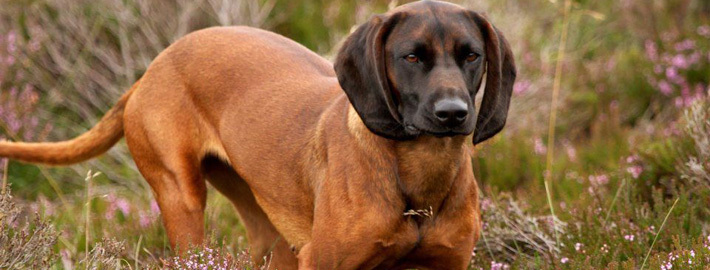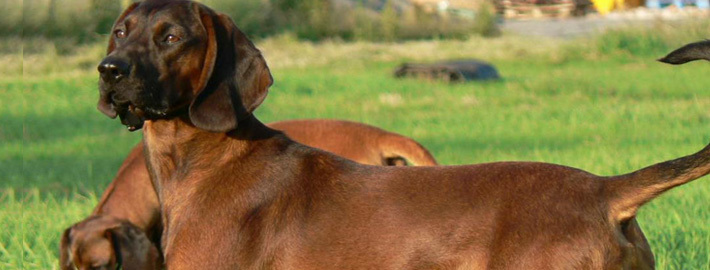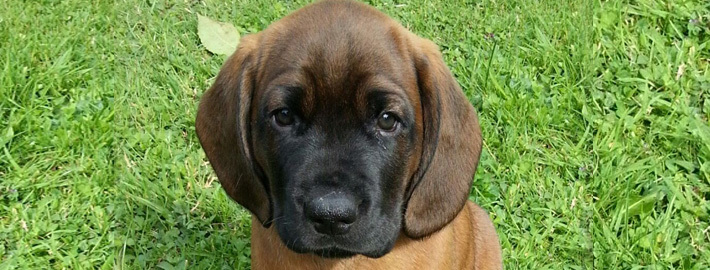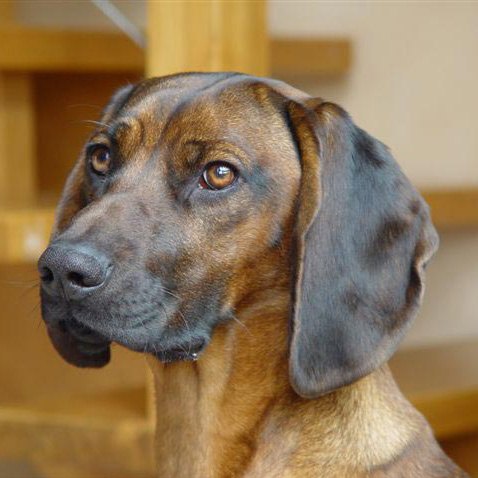What makes the Bavarian Mountain Hound Unique?
A popular breed in its native land, the Bavarian Mountain Dog is relatively unknown in other portions of the world. These scent hounds make great companions for avid hunters.
Breed Groups
Page Contents
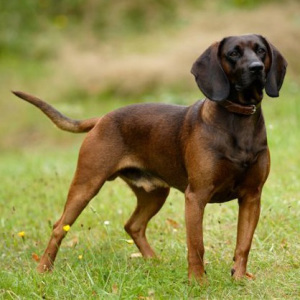
SnapShot
| Size: | Males – 47 to 52 cm (19 to 20 inches) Females – 44 to 48 cm (17 to 19 inches) |
| Weight: | Males – 20 to 25 kg (144.1 to 55.1 pounds) Females – 20 to 25 kg (44.1 to 55.1 pounds) |
| Origin: | Germany |
| Life Span: | 10 – 14 Years |
| Colour: | Red, Brindle, Black-masked fawn, Biscuit, Tan |
| Litter Size: | 7 to 10 puppies |
Is the Bavarian Mountain Hound Right For You?
Bavarian Mountain Hounds are generally calm and quite poised. However, they are known to be an affectionately demonstrative breed with their wagging tails and constant kisses. They are generally considered to be good with children. Although members of this breed were developed as hunting dogs, they are nonetheless intensely loyal and completely devoted to their human family members.
As members of this breed need plenty of exercise, Bavarian Mountain Hounds are a poor choice for city dwellers with small or nonexistent yards. These dogs need a trainer that has previous experience and plenty of patience. They are not suitable pets for folks that only go hunting on rare occasions. Bavarian Mountain Hounds will become destructive if not given enough to do. Many of these dogs are the breed of choice for game wardens and forest rangers in their native land.
In 5 Words
- Spirited
- Agile
- Loyal
- Calm
- Quiet
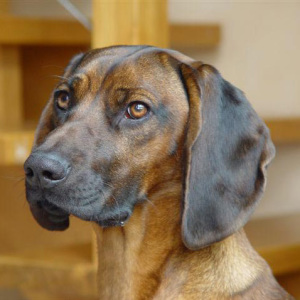
Characteristics
Learn About the Bavarian Mountain Hound
Description
General Description
Bavarian Mountain Hounds possess elongated heads with broad, domed skulls. Their somewhat curved noses should be either dark red or black in color. They also should have dignified expression in their dark brown eyes. These dogs have solid jaws and wide muzzles. Members of this breed should have a slight dewlap on their medium-sized necks. High set, medium sized ears are another feature of this breed. These appendages should lean against the dog’s head. The ears should additionally have curved tips and a wide base. Bavarian Mountain Hounds have long, muscular bodies with an elevated posterior. Their wide chest should be well-developed. These dogs have a medium length tail that can either be carried in a downward position or it can be level with the ground.
Size
On average, Bavarian Mountain Hounds weigh between 44 to 55 pounds (20 to 25 kilograms). The females are somewhat shorter than their male contemporaries. They stand 17 to 19 inches (44 to 48 centimeters) tall, while the males reach between 18.5 and 20.5 inches (47 and 52 centimeters) in height. It is considered a serious fault by the United Kennel Club for members of this breed to not follow the appropriate height regulations.
Coat
These dogs have a short, glossy coat that is somewhat coarse in texture. However, their fur is softer on their ears and head than it is elsewhere. Lengthier fur is found on the tail, legs, and abdomen of this breed. A coat that is too thin or sparse can result in the dog in question being disqualified from the show ring. Although most dogs of this breed come in fawn hues and have black masks, Bavarian Mountain Hounds are additionally available in varying shades of brindle. White markings on their chests are likewise permitted by the United Kennel Club breed standards.
Short History of the Bavarian Mountain Hound
Since the Middle Ages, allowing severely wounded animals to die of their injuries has been considered poor sportsmanship. Therefore, hunters have employed bloodhounds to find these creatures so they could be promptly dispatched. The Germans eventually began breeding medium-sized dogs with drooping ears and a sturdy build for this purpose. During the 1800s, Montes Alpes hunting dogs and members of the Hannoversche Schweißhund breed were crossbred to produce the ancestors of the modern Bavarian Mountain Dog. By 1912, Munich had become the home of a breed fancier club. These dogs later spread to the neighboring countries of Austria and Hungary. The Bavarian Mountain Hound was eventually accepted into the Fédération Cynologique Internationale (FCI) in 1959.
Temperament
Although members of this breed were developed as hunting dogs, they are nonetheless intensely loyal and completely devoted to their human family members. They are generally calm and quite poised. However, Bavarian Mountain Hounds are known to be an affectionately demonstrative breed with their wagging tails and constant kisses. They are generally considered to be good with children. When not working, Bavarian Mountain Hounds want to be around their families or else extreme separation anxiety can result. This is not an appropriate breed for life in a kennel. Yet Bavarian Mountain Hounds can be aloof around strangers, almost to the point of shyness. However, extreme shyness is considered to be a breed fault.
It seems these dogs have bit of a split personality because they change radically in disposition when on the hunt. This breed is very persistent and focused when they are hunting, even on difficult terrain. Like most scent hounds, Bavarian Mountain Hounds have an excellent sense of smell. Owners of this breed will need to be careful and not let these dogs get out of their sight because otherwise these hounds can be so focused on their prey that they end up lost as a result. These dogs can also be incredibly vocal.
Caring for Your Bavarian Mountain Hound
General Health
Bavarian Mountain Hounds are hardy creatures that typically live between 10 and 15 years. Although some difficulties have arisen as the result of poor breeding practices, health issues that are problematic for other breeds don’t seem be as prevalent among these dogs. However, there are a number of difficulties that can arise.
Many different breeds including the Bavarian Mountain Hound can suffer from hip dysplasia. This genetic condition includes a variety of problems related to the hip joints. It is recommended that owners have their dogs tested for this ailment when they reach a year old. Another typical problem that affects Bavarian Mountain Hounds is entropion, a painful eye condition. The condition can be cured through surgery but, if left untreated, it can cause scarring and corneal ulcers. Members of this breed may also suffer from epilepsy. This hereditary illness manifests itself in the form of seizures. While pricey medicine is available to control this condition, there is no actual cure.
Care
Daily
This breed requires at least two hours of exercise per day.
Weekly
These dogs will need their long ears cleaned on a regular basis to prevent infections from occurring. It is also a good idea to brush a dog’s teeth on a regular basis to prevent bad breath and the onset of periodontal disease.
Monthly
All pets need to take heartworm, flea, and tick prevention medications on a regular basis. Most products will need to be administered once per month.
Grooming & Bathing
These dogs do not need extensive amounts of grooming. An occasional brushing will suffice.
Exercise & Training
As members of this breed need plenty of exercise, Bavarian Mountain Hounds are a poor choice for city dwellers with small or nonexistent yards. These dogs need a trainer that has previous experience and plenty of patience. They are not suitable pets for folks that only go hunting on rare occasions. Bavarian Mountain Hounds will become destructive if not given enough to do. Many of these dogs are the breed of choice for game wardens and forest rangers in their native land.

